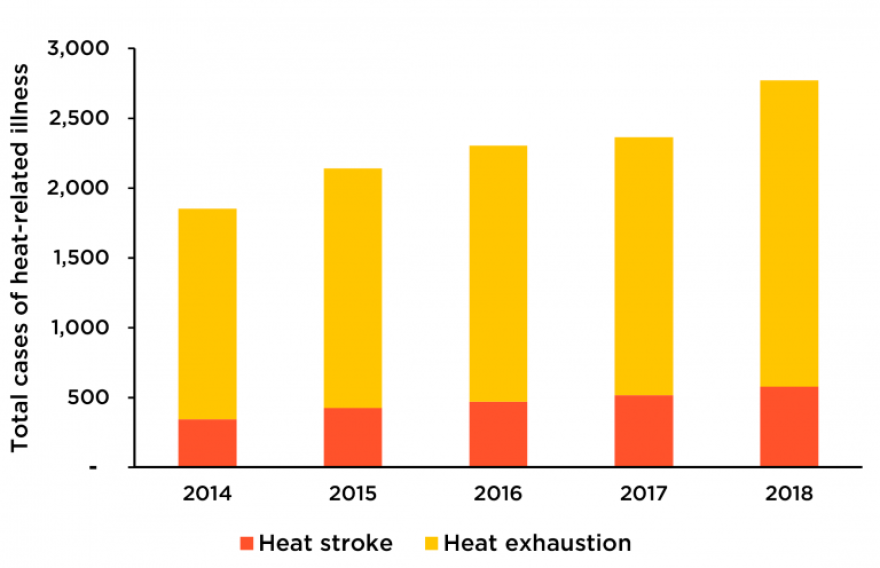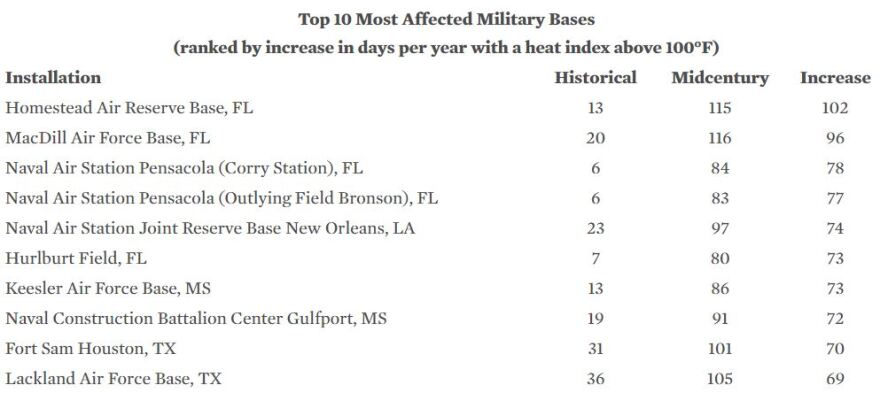Jacksonville’s Naval Station Mayport is among the many military bases that will have to deal with significantly hotter days, according to a new report from the Union of Concerned Scientists. Mayport has historically seen eight days a year with heat index values over 100 degrees. By 2050, that number is projected to jump to 74 days.
That’s as U.S. military installations worldwide are projected to experience nearly five times as many superhot days on average.
The report, US Military on the Front Lines of Extreme Heat, highlights the threat an increasingly hot world poses to the military. That’s after a previous report called Killer Heat outlined how dangerously hot days are projected to become more and more common over the next century if fossil fuel emissions aren’t quickly and sharply reduced.
Related: Jacksonville Could See More Dangerously Hot Days Unless Greenhouse Gases Are Cut
The annual rates of heat stroke diagnoses among active-duty members has been rising steadily since 2014, and heat exhaustion diagnoses peaked in 2018. That year alone, there were nearly 2,800 reported cases, with just 67 occurring in Iraq and Afghanistan. In fact, more than 90% of all reported heat-related illnesses among U.S. service members occur in the U.S.

“The military has guidelines in place for preventing heat-related illness, but it’s still seeing an increase in service members’ getting sick,” said Shana Udvardy, climate resilience analyst at UCS and co-author of the study. “These guidelines may need to be updated to reflect growing risks and must be diligently enforced especially during extreme heat days. Adjustments may have to be made in the times of day or year when it’s safe for soldiers to train outdoors.”

According to the Military Health System, heat-related illness is already a “significant threat to the health and operational effectiveness of military members and their units and accounts for considerable morbidity, particularly during recruit training in the U.S. military,” despite heat protection standards that are already in place.
Related: The Navy Is On The Front Lines Of Adapting To Climate Change
Of the ten military bases that are expected to be affected most, five are in Florida.
“The three hottest bases by midcentury—Marine Corps Air Station in Yuma, Arizona; MacDill Air Force Base in Florida; and Homestead Air Reserve Base in Florida—would each experience the equivalent of nearly four months per year with a heat index over 100 degrees Fahrenheit,” said Kristy Dahl, a senior climate scientist at UCS and the lead author of the study. “The growing number of dangerously hot days could pose a challenge to the military’s efforts to protect service members’ health while also ensuring mission readiness.”
Historically, only nine major military installations in the U.S. have experienced 30 or more days per year with temperatures that high. By midcentury, again, with no action to reduce emissions, 100 installations could see a month or more of those dangerously high temperatures.

“The best thing we can do to keep our troops—and by extension the country—safe from these worsening conditions is to enact policies that encourage a rapid transition to a clean energy economy,” Udvardy said. “At the same time, we should be working with the rest of the world through the Paris climate agreement to rapidly and dramatically reduce carbon emissions. That would significantly limit the increase in dangerously hot days ahead and protect our most vulnerable communities.”
Heat kills more people in the U.S. than any other type of weather event. Over the past three decades, it has contributed to an average of 136 deaths per year.
Brendan Rivers can be reached at brivers@wjct.org, 904-358-6396 or on Twitter at @BrendanRivers.







